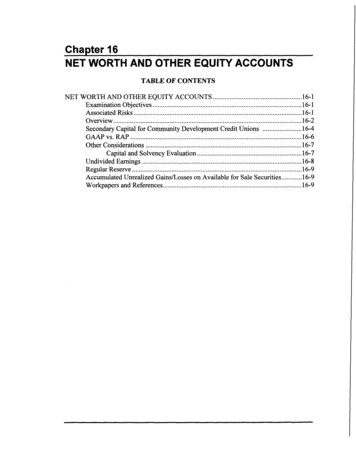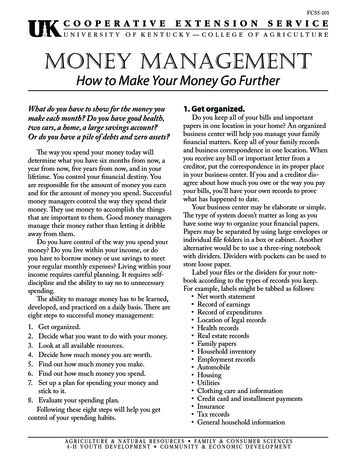
Transcription
Chapter 16NET WORTH AND OTHER EQUITY ACCOUNTSTABLE OF CONTENTSNET WORTH AND OTHER EQUITY ACCOUNTS . 16. 1Examination Objectives . 16-1Associated Risks . 16. 1Overview . .16.2Secondary Capital for Community Development Credit Unions . 16-4GAAP vs . RAP .16-6Other Considerations . 16-7Capital and Solvency Evaluation . 16.716-8Undivided Earnings .Regular Reserve . 6-9Accumulated Unrealized GainsLosses on Available for Sale Securities.16-916-9Workpapers and References.
Chapter 16NET WORTH AND OTHER EQUITY s000Determine whether the credit union complies with Regulation D,if applicableAscertain compliance with the Credit Union Membership AccessAct (CUMAA)Determine whether the credit union has sufficient net worth forits degree of riskDetermine whether the credit union has adequate policies,practices, and procedures regarding net worth and capitalaccountsDetermine if officials and employees adhere to establishedpolicies, practices, and procedures regarding net worth andcapital accountsDetermine whether reserve accounts are audited periodicallyDetermine whether reserve accounts comply with the CUMAA,FCU Act, NCUA Rules and Regulations, and appropriateaccounting guidanceDetermine if the credit union promptly corrects deficiencies orviolations noted during examinations or auditsCredit risk can result from poor underwriting of loans or highrisk investments;Interest rate risk can result from insufficient net interest marginto cover operating expenses;Liquidity risk can result from inadequate pricing policies, andfailure to properly structure share and loan products resulting inweak or negative profitability;Strategic risk can result from failure of management to plan forsufficient resources to fulfill business plans or continue offeringcompetitive products and services;Transaction risk can result from failure to establish andimplement policies and procedures that ensure the accuracy andintegrity of data and information;Compliance can result when credit unions fail to comply withapplicable laws and regulations; andPage 16-1
EXAMINER’S GUIDEReputation risk can result from loss of member confidence andwithdrawal of member shares due to questions regarding thecredit union’s on-going viability.OverviewThe adequacy of the credit union’s reserves should correlate to theamount of risk it has taken or plans to take.Two types of reserves apply to credit unions: cash reserves andequity reserves. Cash reserves include transaction account reservesrequired by Regulation D. Credit unions hold cash reserves in thefollowing forms:Vault cash;A balance maintained directly with the Federal Reserve Bank(FRB) in the District in which the credit union is located; orA pass-through account, which is considered a balancemaintained with the FRB.Cash reserves usually do not apply to smaller credit unions;however, equity reserves apply to all credit unions. Credit unionsestablish equity reserves (also called capital) by segregating part oftheir net income into reserve and undivided earnings accounts.Equity reserves may be either appropriated or unappropriated.A credit union’s capital is defined as the total of its regular reserves,allowance for loan and lease losses, special reserves, undividedearnings, accumulated unrealized gains or losses on available-for-sale(AFS) securities, and that portion of year-to-date net income that hasnot yet been closed to the appropriate capital account. Capitalaccounts provide (1) a cushion for anticipated and unidentifiedlosses, (2) a base for future growth, and (3) a means by which thecredit union can meet competitive pressures as they arise. Capitalprovides the credit union a cost-free source of funds.Net worth is defined as the retained earnings balance of the creditunion at quarter end as determined under generally acceptedaccounting principles (GAAP). See the FCU Act §216(d)(o)(2).Retained earnings consist of undivided earnings, regular reserves,and any other appropriations designated by management orPage 16-2
NET WORTH AND OTHER EQUITY ACCOUNTSregulatory authorities. Net worth does not include the Allowance forLoan and Lease Losses account. This means that net worth onlyincludes undivided earnings and appropriations of undividedearnings. (Refer to the Prompt Corrective Action chapter of thisGuide for additional information.)A strong net worth position enables a credit union to take on morerisk than can a credit union with a weak net worth position. Astronger overall net worth position better enables a credit union todeal with future uncertainties such as asset losses, sponsor layoffs,and adverse economic cycles.The credit union board should have a plan for defining andmaintaining an adequate net worth level. The examiner shouldreview the net worth position and the officials' philosophy towardbuilding and maintaining net worth. If the net worth position doesnot meet the credit union's short- or long-term needs, the examinershould determine if the shortfall poses a threat to safety andsoundness.Examiners may find the following ratios useful in reviewing capitaland net worth:Net Worth to Assets;Net Worth Growth vs. Asset Growth (trend);Capital to Assets;Net Capital to Assets;Capital Growth to Asset Growth;Net Worth to Loans;Classified Assets to Net Worth;Total Delinquent Loans to Net Worth; andSolvency Evaluation.When analyzing the adequacy of reserves and net worth, examinersshould consider the following factors:88Size of the credit union;Complexity of products and services;Degree of sponsor support;Level of management's expertise;Page 16-3
EXAMINER’S GUIDE00000Quality of management’s due diligence for existing and newproducts, services and systems;Involvement of the officials;Interest rate risk;Internal control structure;Stability and diversity of the field of membership; andConcentrations of credit and savings.Examiners should also consider the amount of coverage provided bythe credit union’s surety bond. §713.5(a) of the NCUA Rules andRegulations defines the minimum coverage required. Some of thenewer bond forms provide significantly less coverage than thestandard bond. Examiners should ensure the credit union maintainsadequate bond coverage. See the Bond Coverage chapter of thisGuide for additional guidance.SecondaryCapital forCommunityDevelopmentCredit UnionsFederally insured credit unions designated as low-income mayestablish secondary capital accounts, which examiners should reviewfor compliance with §701.34(b) of the NCUA Rules and Regulations.Before offering secondary capital accounts, the credit union mustadopt, and forward to the appropriate regional director, a writtenplan for use of the secondary capital account funds and subsequentliquidity needs to meet repayment requirements upon maturity of theaccounts.The following restrictions apply to these secondary capital accounts:0Establishment as an uninsured secondary capital account or otherform of non-share account;0Minimum five years maturity;0Not redeemable before maturity;Not insured by the National Credit Union Share Insurance Fund(NCUSIF) or any governmental or private entity;Page 16-4
NET WORTH AND OTHER EQUITY ACCOUNTS0Holder’s claim against the credit union is subordinate to all otherclaims, including those of shareholders, creditors, and theNCUSIF;Required availability of funds deposited, including interestaccrued and paid into the secondary capital account, to covercredit union’s operating losses that exceed net available reservesand undivided earnings (i.e., exclusive of allowance accounts forloan and lease losses.) Credit unions may not replenish theaccount for funds so used. Credit unions may pay interestaccrued on the secondary capital account directly to the investoror into a separate account available to the investor forwithdrawals. Pro-rata distribution of realized losses among allsecondary capital accounts held by the credit union is required;0May not pledge as security on a loan or other obligation with thecredit union or any other party;Account funds not needed for covering losses at the time ofmerger (other than merger into another low-income designatedcredit union) or voluntary dissolution will be closed and paid outto the account holder;Contract containing terms and conditions required betweenrepresentative of the account holder and the credit union; andDisclosure and acknowledgment signed by representative ofaccount holder is required and the account holder will receivecopies of contract and disclosure at the time of entering into theaccount agreement (see the Appendix to 5701.34 of the NCUARules and Regulations.) Credit unions must retain original copiesof the contract and the disclosure and acknowledgment for theterm of the agreement.The regulation establishes a declining scale for the capital value ofaccounts with less than five years remaining maturity. Even so, allfunds will continue to be at risk to cover losses that exceed reservesand undivided earnings. The declining scale addresses accounts withremaining maturities of at least the following:Page 16-5
EXAMINER’S GUIDEFour years, but less than five years - counted as capital at 80percent of face value;Three years, but less than four years - counted as capital at 60percent of face value;Two years, but less than three years - counted as capital at 40percent of face value;One year, but less than two years - counted as capital at 20percent of face value; andLess than one year remaining maturity - counted as capital at 0percent of face value.Examiners should review the disclosure and acknowledgment that theaccount holder’s authorized representative must provide and execute.(See disclosure in the Appendix to 5701.34 of the NCUA Rules andRegulations. )GAAP vs.RAPGAAP classifies secondary capital accounts as subordinated debt. Assuch, the account holder does not have voting or ownership rights.However, NCUA adopted a regulatory accounting position (RAP)that recognizes secondary capital accounts for low-income designatedcredit unions as capital accounts. This RAP position applies to allcredit unions having a low-income designation, including those withassets equal to or greater than ten million. Examiners shouldunderstand that the credit union’s outside auditor may recognizethese accounts as subordinated debt, and reflect the entire balance inthese accounts in the liability section of the balance sheet consistentwith GAAP for financial statement presentation.Examiners should record secondary capital as “Other RevocableReserves’’ in the equity section of the balance sheet to ensure theirinclusion in capital when AIRES calculates CAMEL component andcomposite ratings. For secondary capital accounts having aremaining maturity of less than 5 years, AIRES requires examinersto split them into capital (Other Revocable Reserves) and non-capital(Other Liabilities) components based on the sliding scale (see theNCUA Rules and Regulations §701.34(c)).The credit union records secondary capital accounts that have capitalvalue (based on the sliding scale) as “Secondary Capital -Page 16-6
NET WORTH AND OTHER EQUITY ACCOUNTSUninsured”. Credit unions must transfer the portion of secondarycapital accounts not considered capital to “Subordinated CDCUDebt” (The Accounting Manual for Federal Credit Unions containsmore information on this subject.)When reviewing call reports of low-income designated credit unionsthat have secondary capital accounts, examiners should ensure properrecording of these accounts. Credit unions should not use theUninsured Secondary Capital line on the call report for reporting anyother type of capital.OtherConsiderationsA low-income credit union must include secondary capital accountsin its total borrowing amount. The FCU Act §107(9) limits creditunion borrowing to 50 percent of paid-in and unimpaired capital andsurplus.Part 705 of the NCUA Rules and Regulations addresses theCommunity Development Revolving Loan Program for CreditUnions (the Program). A participating credit union may receive up to 300,000 in the form of a loan, which the credit union must matchby increasing its shares by a like amount (see the Low-Income CreditUnion chapter of this Guide for more information about theProgram). The regulation’s matching requirement encourages creditunions to develop a permanent source of member shares as rapidly aspossible.Since secondary capital accounts are not member share accounts,low-income designated credit unions may not use secondary capitalaccounts as matching funds for purposes of the Program.Additionally, the limitations on public unit and nonmember accountsdescribed in §701.32(b) do not apply to secondary capital accounts.Capital andSolvencyEvaIuationWhen reviewing reserve accounts, the examiner should considercapital adequacy, net worth, trends, materiality, unusual activity,and thoroughness of the audit work. In addition, the level of capitalin relation to the perceived level of risk will determine the degree ofreview.Page 16-7
EXAMINER'S GUIDEUndividedEarningsThe examiner should determine that the credit union appropriatelyaccounts for its undivided earnings account. It should pay particularattention to the positive and negative growth trends of this account.A decreasing trend may trigger a detailed review to determine thecause.When analyzing the adequacy of the undivided earnings account, theexaminer should consider the following:0Current and anticipated earnings capacity of the credit union;Quality of the loan and investment portfolios (overallassessment); andUnanticipated events, such as adverse economic conditionscausing plant closings, layoffs, etc.Credit unions cannot pay dividends, without the prior approval of theregional director if the payment results in a deficit in the undividedearnings account. Credit unions experiencing a deficit, or those inwhich paying a dividend would result in a deficit, must request andreceive approval for 208 Assistance before paying dividends.If a credit union has a deficit balance in the undivided earningsaccount at the time of the examination, the examiner shoulddetermine if it paid a dividend during the last accounting period. If itdid pay a dividend, the dividend was material, and the examinerbelieves there was obvious intent on the part of the officials to pay anillegal dividend, then the examiner should consider initiating anadministrative action against the responsible parties. The examinershould not recommend that the officials recall the dividend becauseneither the officials nor the NCUA Board has that authority. If theshareholders received the illegal dividend in good faith and withoutknowledge of the credit union's financial condition, they have nolegal obligation to refund the dividend.However, the examiner should reach an agreement with the officialsthat a dividend declared at the end of the next accounting period willnot exceed available earnings after elimination of the deficit.Examiners should treat an illegal dividend as an area of concern.Page 16-8
NET WORTH AND OTHER EQUITY ACCOUNTSRegularReserveThe regular reserve is a statutory reserve account. When analyzingthe adequacy of this account’s balance, the examiner should considerthe credit union’s compliance with statutory reserving requirements,including net worth restoration plans. Refer to 5702.201 of theNCUA Rules and Regulations for guidance on transfers into thisaccount.AccumulatedUnreaIizedGains/Losseson Availablefor SaleSecuritiesThis account records unrealized gains and losses on available for salesecurities. When credit unions write available for sale securities tofair value, they make an entry directly to the investment account withthe corresponding debit or credit to the accumulated unrealized gainand losses on the available for sale securities account. The creditunion nets this account against undivided earnings when assessing acredit union’s ability to pay dividends.WorkpapersandReferencesWorkpapers- Regular Reserves- Undivided Earnings- Accumulated Unrealized GaidLoss on Investments- Special Reserves- Other Reserves- Contingency- Appropriated Undivided Earnings- Critical SolvencyReferences- Federal Credit Union Act107(9) - Borrowing Limitation216 - Prompt Corrective Action- NCUA Rules and Regulations701.32 - Payment on Shares by Public Unitsand Nonmembers701.34 (Appendix) - Disclosures andAcknowledgment702 - Prompt Corrective Action702.2(f) - Definition of Net Worth702.34(b) - Receipt of Secondary Capital Accounts byLow-Income Designated Credit Unions702.401 - ReservesPage 16-9
EXAMINER'S GUIDE-Page 16-10705.7 - Loans to Participating Credit Unions713 - Fidelity Bond and Insurance Coverage forFederal Credit UnionsNCUA Letter to Credit Unions #182, dated November 1995NCUA Instruction No. 4020NCUA Accounting Bulletin 95-1
If the net worth position does not meet the credit union's short- or long-term needs, the examiner should determine if the shortfall poses a threat to safety and soundness. Examiners may find the following ratios useful in reviewing capital and net worth: Net Worth to Assets; Net Worth Growth vs. Asset Growth (trend); Capital to Assets;










